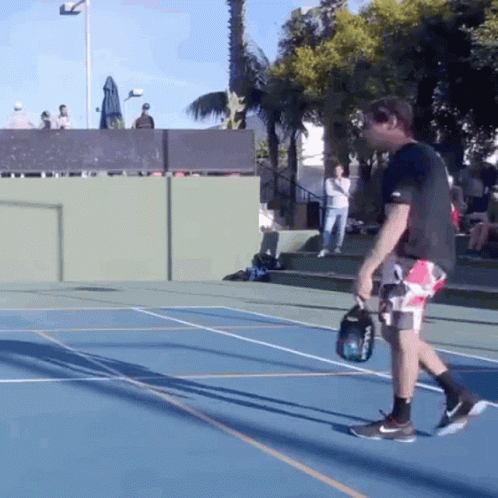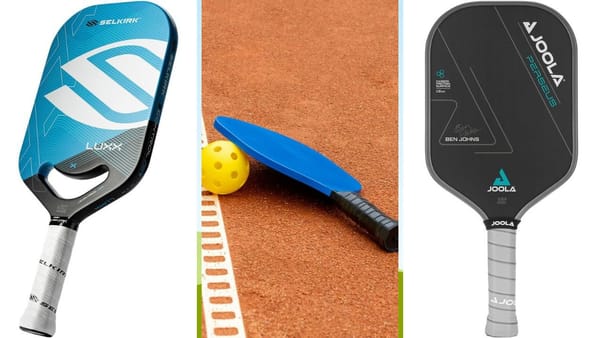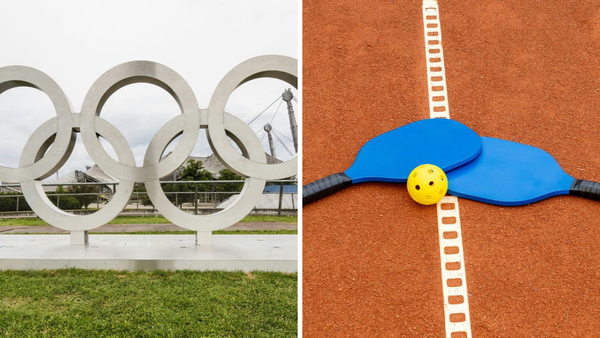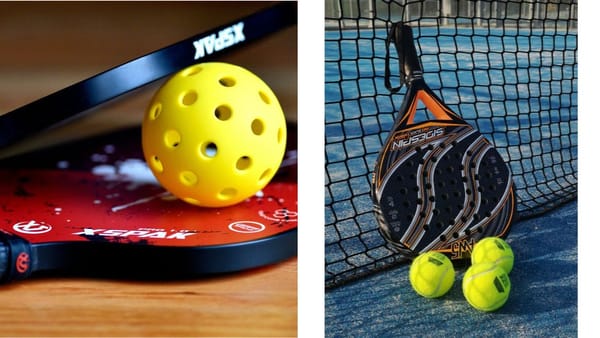How did pickleball get its name you ask? Pickleball is a name that doesn't immediately conjure up images of an increasingly popular paddle sport. Is it food? Is it a nickname for a mischievous pet?
The answer is neither. In this post, we'll uncover the history of how Pickleball got its name, and reveal the surprising player behind it all.
Pickleball. A sport that has taken the world by storm. Well, it's all thanks to just a funny story involving table tennis paddles and a family dog.
Urban Legend
First, let's get one popular misconception out of the way — despite what an urban legend perpetuates, Pickleball has nothing to do with pickling cucumbers.
Legend has it that Joel Pritchard and Bill Bell, two dads with cabin fever in joels father's garage workshop garage, were looking for something to do one weekend in 1965. They stumbled upon a badminton court but couldn't find the shuttlecock. From there, a permanent pickleball court appeared!
Instead of giving up, they improvised with some table tennis paddles and a whiffle ball. It wasn't long before Joel's adorable cocker spaniel, Pickles, joined in on the fun.
From that day forward, the game started to take shape, and they named it after Pickles. Yup, that's right. This popular sport with an even more popular name was born out of Joel's cute dog story and the Pritchard family! And that's how the game started!

The Family Dog
According to one of the game's founding members, Joel Pritchard, Pickleball was named after the family's dog,
Pickles. At the time, Pickles was known for frequently stealing the ball players used during the game and hiding it in the bushes.
So when the time came to officially name their new invention, the group collectively agreed "Pickleball" was fitting, and the name stuck.
Pickle Boat?
However, other theories challenge Pritchard's recollection. Some speculate that Pickleball may have derived its name from the "pickle boat," a term used in the crew that refers to a vessel that picks up stray rowers who aren't matched with a full team.
The theory goes that the founders of Pickleball were already avid rowers, and may have co-opted the term for their new game as a tribute to their love of the water.
Another theory posits the name came from the term "pickle." In another version, Pritchard introduced the game to other players, who joked that it was a "mixed-up" version of other sports, and like a pickle dish, combining multiple things.
But ultimately, we may never know which theory is the true origin story of Pickleball's unique and quirky name.
How Did Pickleball Get Its Name
Explosion Of The Sport
Since then, Pickleball and other racket sports have grown into international sports, with more than 2.5 million players worldwide.
It is now part of the U.S. Open Pickleball Championships and even the Special Olympics!
So while Pickles may no longer be running around a court stealing balls from unsuspecting players, his legacy lives on in the name of one of today's favorite paddle sports.
Now that you know how Pickleball got its name, grab your paddles and get out there to join the millions of people playing this exciting game!
Who knows — maybe you'll be able to find that special someone (or their dog) who will help you get into the world of pickleball. We guarantee it'll be an experience you won't soon forget! Good luck and have fun.
How Pickleball Differs From Tennis
Pickleball and tennis may share some similarities in terms of being racquet sports played on a court, but they have distinct characteristics that set them apart. One significant difference lies in the equipment used.
Tennis utilizes a larger, heavier racket and a felt-covered tennis ball, whereas pickleball employs a smaller, lightweight paddle made of composite materials and a unique plastic ball with holes, resembling a Wiffle ball.
The court dimensions also differ between the two sports. A tennis court is larger, measuring 78 feet long and 27 feet wide for singles matches, and 78 feet long and 36 feet wide for doubles matches.
In contrast, a pickleball court is just 20 feet wide and 44 feet long for doubles play, which is the most common format.
The smaller court size in pickleball allows for a faster-paced and more dynamic gameplay, with players being able to cover the entire court more efficiently.
Another contrasting factor is the serving technique. In tennis, the server must stand behind the baseline and hit the ball diagonally into the opponent's service box, aiming to start the point.
However, in pickleball, the server must use an underhand technique, keeping at least one foot behind the baseline while striking the ball below waist level and directing it diagonally into the opponent's service area.
The underhand serve in pickleball contributes to a fairer gameplay and enables players of all ages and skill levels to participate comfortably.
Furthermore, the scoring system sets these two sports apart.
Tennis typically follows a traditional scoring system, with points awarded as 15, 30, 40, and then game. If both players reach 40, it goes to deuce, and they must win by two clear points.
In pickleball, a simplified scoring system is used, where points are only awarded on the serving team's side. The serving team starts with zero points, and a point is scored on each rally won. Games are typically played to 11 or 15 points, depending on the agreed-upon rules.
Lastly, the pace of play distinguishes pickleball from tennis. While tennis can involve longer rallies and more extended matches, pickleball offers quicker exchanges due to the smaller court size and the characteristics of the plastic ball.
The nature of pickleball encourages fast reflexes, agility, and strategic shot placement, as players must adapt to the faster pace and maneuverability within the limited court space.
In conclusion, pickleball and tennis may share some fundamental principles as racquet sports played on a court, but their differences in equipment, court dimensions, serving techniques, scoring systems, and pace of play contribute to distinct experiences for players.
Whether one prefers the larger court and powerful strokes of tennis or the quick, dynamic gameplay of pickleball, both sports offer unique and enjoyable opportunities for individuals to engage in friendly competition and active recreation.
How Did Pickleball Get Its Name?
Some Final Thoughts
Regardless of where the name came from, it's clear that Pickleball has come a long way from its humble origins on a quiet island in the Pacific Northwest.
With its accessible rules, simple equipment, and friendly community, Pickleball has become a sport beloved not only by families looking for fun in the sun but by athletes of all ages and skill levels.
So whether you're a seasoned veteran or a newbie just learning the ropes, remember the curious history behind the name of the game you've come to love.
And if you meet a dog named Pickles along the way, be sure to give them an extra pat for being the unwitting inspiration behind it all.
FAQ's
Q1: What is pickleball?
Pickleball is a paddle sport that combines elements of tennis, badminton, and table tennis. It is played on a smaller court with a paddle and a plastic ball with holes.
Q2: How do you play pickleball?
Pickleball is played with two or four players. The ball is served diagonally, and players must allow it to bounce once on each side before hitting it back over the net. The objective is to score points by hitting the ball past the opponent without committing faults.
Q3: Can anyone play pickleball?
Yes, pickleball is a sport suitable for people of all ages and skill levels. Its smaller court size and slower pace compared to tennis make it accessible and enjoyable for beginners, yet it also offers opportunities for advanced players to showcase their skills.
Q4 What equipment do I need to play pickleball?
To play pickleball, you will need a pickleball paddle, which is smaller than a tennis racket, and a pickleball, which is a plastic ball with holes. It is also recommended to wear comfortable athletic shoes and appropriate clothing for ease of movement.
Q5: Is pickleball played indoors or outdoors?
Pickleball can be played both indoors and outdoors. It is a versatile sport that can be enjoyed on various surfaces such as tennis courts, gymnasiums, or purpose-built pickleball courts.
Q6: What are the health benefits of playing pickleball?
Pickleball offers numerous health benefits, including improved cardiovascular fitness, increased agility and coordination, enhanced muscle strength and endurance, and a fun way to stay active and socialize.
Q7: How long does a pickleball game typically last?
The duration of a pickleball game can vary depending on factors such as the skill level of the players and the scoring system used. On average, a game can last anywhere from 15 minutes to 45 minutes.
Q8: Can you play pickleball singles?
Yes, pickleball can be played in both singles and doubles formats. While doubles is more common, singles pickleball allows players to showcase their individual skills and strategic play.
Q9: Are there official pickleball rules?
Yes, the International Federation of Pickle ball (IFP) has established official rules and regulations for the sport. These rules cover aspects such as court dimensions, serving techniques, scoring, and faults.
Q10: Can pickleball be played competitively?
Absolutely! Pickleball has grown in popularity and now has competitive tournaments at local, regional, national, and international levels. Players can participate in leagues, clubs, and organized events to test their skills and compete against other players.










Member discussion